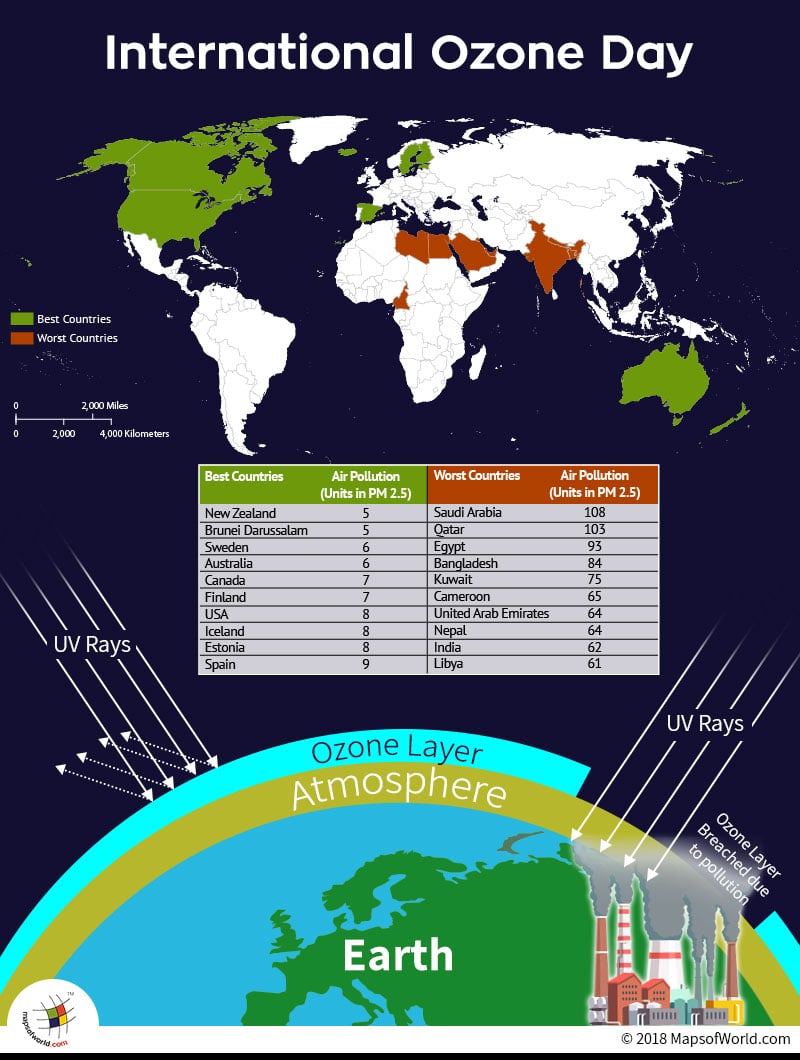What countries have worst air pollution levels?
The ozone layer is a fragile shield of gas that contains high concentrations of ozone(O3), that absorbs most of the sun’s ultraviolet radiations, and sustains life on the planet. Hence, the concern of ozone thinning over the South Pole needs to be addressed.
Approaching the growing need to preserve the ozone layer, the United Nations General Assembly, designated September 16th as the ‘International Day for the Preservation of Ozone Layer‘. This was done to commemorate the date on which the nations collectively signed the ‘Montreal Protocol on Substances that Deplete the Ozone Layer’.
The ‘Ozone Hole’:
The ozone depleting substances are present throughout the stratosphere, transported by air motions. But the severe depletion over the Antarctic region is due to the prevalence of different atmospheric and chemical conditions. The low temperatures of the region adds to the formation of the Polar Stratospheric Clouds, that results in higher diminishings in the Antarctic region.
The Polar Stratospheric Clouds, support chemical reactions that produce active chlorine which aids in the ozone destruction and disturbs the other gas cycles like nitrogen.
The other main contributor to the ozone hole is the emission of Halogen gases. The sources of halogen gases are present in abundance in the Northern Hemisphere, but are redistributed through winds and convections, leading to mixing of air efficiently in the troposphere.
Life On Earth:
The depletion of ozone layer has immense effects on both plants and micro-organisms of the planet. The ultraviolet rays impacts on human life can be seen through prevalent skin cancers like malignant melanoma and basal and squamous cell carcinoma, eye damages like cataracts, photokeratitis(snow blindness), damaged immune systems by weakening the responses of the immune system and accelerated ageing of skin including allergies, rashes and often breakouts. It might also hamper breathing and lung functioning.
The marine organisms, phytoplankton and zooplankton are highly sensitive to the ultraviolet rays. It threatens their growth, further affecting all life on the planet, as they play a crucial and a niche role in the complex ecological food webs.
The international observance of this day marks the beginning of the success of the efforts taken towards ozone conservation. The celebration of this day is an indication of the awareness amongst the nations and an achievement in stimulating behavioural changes. The willingness of the masses to curb the use of products that emit CFCs (chlorofluorocarbons) and appliances that can contribute to ozone depletion, is a clear depiction of the agreement’s success. The need to adopt more holistic and conservative habits in the long run and a sustained effort in this direction can help in improving the health of our home planet: Earth.
Below lying tables depicts top 10 countries with the best and worst air pollution levels:
|
Best Countries |
Air Pollution (Units in PM 2.5) |
Worst Countries |
Air Pollution(Units in PM 2.5) |
|
|
New Zealand |
5 |
Saudi Arabia |
108 |
|
|
Brunei Darrusalam |
5 |
Qatar |
103 |
|
|
Sweden |
6 |
Egypt |
93 |
|
|
Australia |
6 |
Bangladesh |
84 |
|
|
Canada |
7 |
Kuwait |
75 |
|
|
Finland |
7 |
Cameroon |
65 |
|
|
USA |
8 |
United Arab Emirates |
64 |
|
|
Iceland |
8 |
Nepal |
64 |
|
|
Estonia |
8 |
India |
62 |
|
|
Spain |
9 |
Libya |
61 |
Know more:
Related maps:



